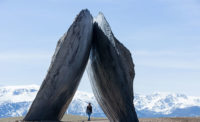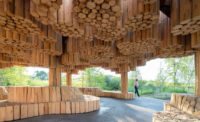Construction Video: Inverted Portal
In the summer of 2013, when the architects Antón García-Abril and Débora Mesa first visited the 11,500-acre Montana cattle and sheep ranch that’s now home to Tippet Rise Art Center, an hour southwest of Billings, they thought it looked like a lunar landscape. Beautiful, yes, but harsh, with few trees, rolling hills, and snow-capped mountains off in the distance.
The husband-and-wife team, principals of the Madrid- and Boston-based firm Ensamble, a 2004 RECORD Vanguard winner, had been asked by Tippet Rise’s founders, Cathy and Peter Halstead, and its director, Alban Bassuet, to create site-specific works for the sculpture park and music venue, which opened on June 17. But the task was daunting. How could any manmade object compete with such a vast natural setting? “We couldn’t find any references, any orientation, to hold and start working with,” García-Abril says. “It was very scary and very creative at the same time.”
In response, they designed pieces that seem to emerge from the landscape. Beartooth Portal comprises two poured-in-place concrete forms that lean delicately against one another. It’s 25 feet tall and set on top of a barren mesa, like some kind of prehistoric monument. Nearby are the similarly designed Inverted Portal and the massive Domo, a 98-foot-long sculpture with a flat top and three “legs” that form caverns for music performances. (Tippet Rise is also home to works by Mark di Suvero, Stephen Talasnik, Patrick Dougherty, and two pieces on loan from the Hirshhorn Museum and Sculpture Garden by Alexander Calder.)
García-Abril and Mesa call their creations “Structures of Landscape.” “We like the ambiguity of the works,” Mesa says. “We like that they look natural, like found objects, but at the same time, you have this impression that they are artificial.”
The sculptures appear to have been designed as they were being built, but, in fact, they were conceived in advance using mockups and computer modeling. Structural engineer Matt Hubbard, of the Bozeman firm Beaudette Consulting Engineers, worked out the complicated construction process.
For Beartooth, the team brought in truckloads of gravel to form two side-by-side pads. Next, a backhoe scooped out some of the gravel to create oblong forms, which were filled with intricate rebar armatures. A crane then lifted the rebar so the holes could be lined with two layers of plastic membrane. After a partial concrete pour, the rebar was reinserted, followed by more concrete and a top layer of dirt and rocks, shoveled by hand. Once the concrete had cured, two cranes lifted the 425,000-pound slabs upright and delicately leaned one against the other.
Structures of Landscape: Beartooth Portal
Video © Ensamble Studio
“It’s like an advanced form of stacking two cards against each other,” says Hubbard, who helped calculate the precise angle of the slabs. Unlike cards, however, the pieces sit on 2-foot-deep concrete footings anchored to bedrock. The slabs are further stabilized by a concrete “cap,” which is hidden by layers of dirt.
The rounded exterior surfaces are smooth, with fabric-like folds and wrinkles created by the plastic liner during the concrete pour. The flatter inside surfaces are rougher, covered with dirt and rocks. The entire process was repeated for Inverted Portal, but with the rough side of the slabs placed on the outside.
Structures of Landscape: Inverted Portal
Video © Ensamble Studio
Guests generally travel the three miles from the visitor center to the portals in electric vans, but may also walk or bike. They see the sculptures and wonder, “How the hell do those things hold together?” says Bassuet, who worked as an acoustician and concert-hall designer for Arup before joining Tippet Rise as its first director. “It’s pure equilibrium.”
For Domo, García-Abril and Mesa deployed a construction technique that was similar to the one used for the portals but did not require any lifting. They formed a mold in a built-up gravel bed for the entire piece, filled it with rebar and concrete, and then—after a month of curing—excavated gravel from underneath. The result is a kind of off-kilter three-legged table, nearly 100 feet long and weighing more than 4 million pounds.
Structures of Landscape: Domo
Video © Ensamble Studio
Domo’s acoustic qualities were revealed in a recent performance by pianist Christopher O’Riley (Tippet Rise’s music director) and soprano Emily Helenbrook. They performed works by García-Abril’s father, Spanish composer Antón García Abril, within the 16-foot-tall sculpture’s interior.
Mesa says that, despite all the planning, there was still a level of uncertainty in the construction process. The surface wrinkles, for example, were completely dependent on how the plastic sheeting was placed in the mold before the concrete was poured. And, given their exposure to Montana’s harsh climate, the pieces will continue to change over time. “That’s OK,” Mesa says. “We want nature to take over.”









Post a comment to this article
Report Abusive Comment